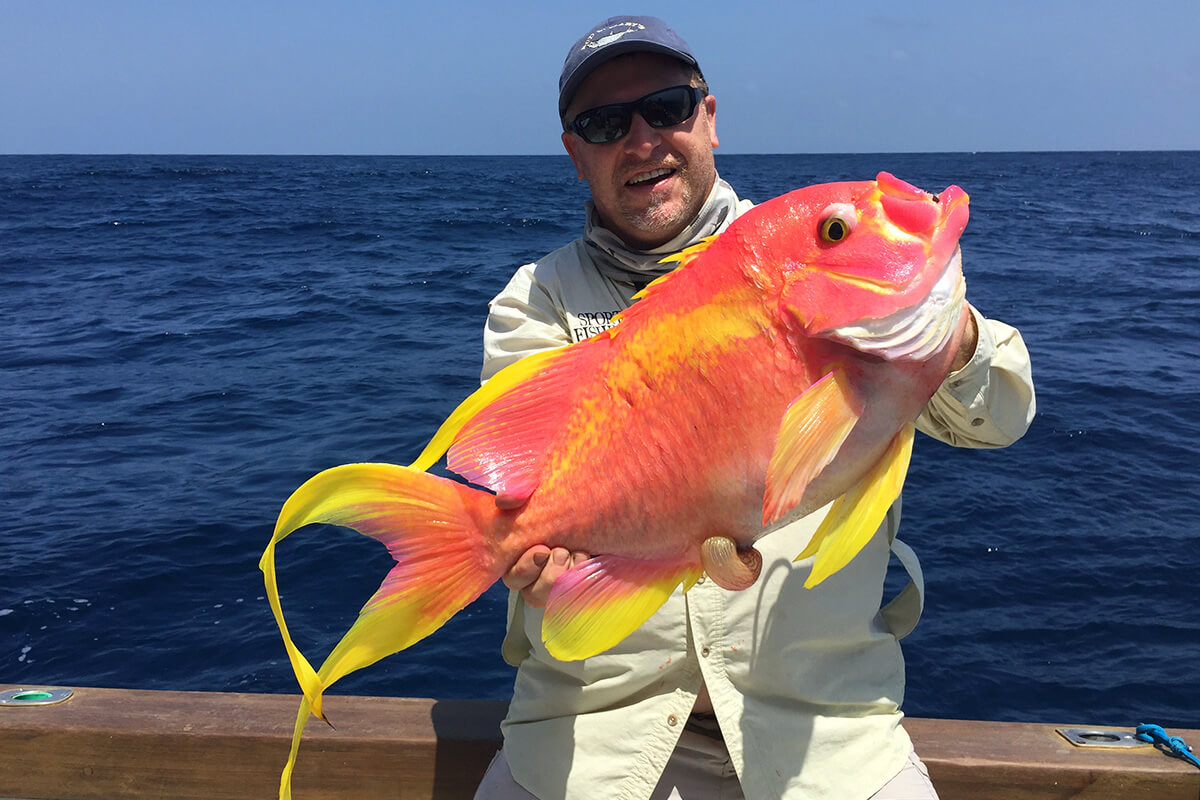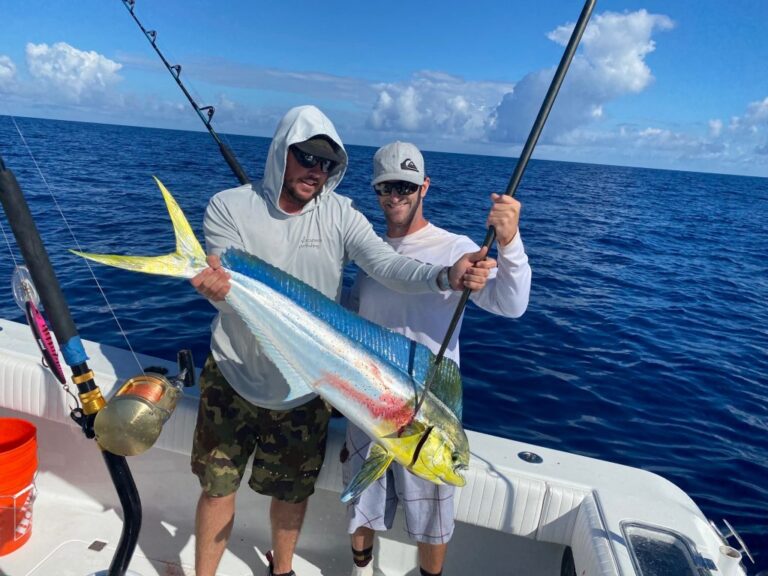To use fish finders for deep sea fishing, start by familiarizing yourself with the device’s features, then adjust the settings to match the fishing conditions and interpret the sonar readings to locate fish. When you’re fishing in deep waters, having a fish finder can greatly enhance your fishing experience.
Fish finders are electronic devices that use sonar technology to detect and display underwater objects, including fish. By understanding how to use them effectively, you can increase your chances of success in catching fish in deep sea waters. We will provide you with a step-by-step guide on how to use fish finders for deep sea fishing.

Credit: www.floridasportsman.com
Understanding The Basics Of Fish Finders
Deep sea fishing can be an exciting and fulfilling experience, but it’s not always easy to locate fish in vast bodies of water. This is where fish finders come into play, as these handy devices can help you pinpoint the best fishing spots and increase your chances of a successful catch.
In this section, we’ll delve into the basics of fish finders, exploring how they work, the different types available, and how to choose the right one for deep sea fishing.
How Do Fish Finders Work?
Fish finders rely on sonar technology to detect and display underwater objects, including fish, rocks, and vegetation. Here’s a breakdown of how these devices function:
- Transducer: The transducer is the key component of a fish finder and is typically mounted on the bottom of your boat or kayak. It emits sound waves, or sonar signals, into the water.
- Sonar signals: These signals travel through the water until they hit an object, such as a fish or the seabed. When the signals encounter an object, they bounce back to the transducer.
- Echoes: The transducer receives the echoes and sends them to the fish finder’s display screen. The device then processes the information and generates a visual representation.
- Display screen: The fish finder’s display screen shows the information gathered by the transducer. This can include depth readings, fish arches, and underwater structures.
- Interpretation: It’s important to note that fish finders do not directly identify fish species. Instead, they provide information on the presence of objects underwater, allowing you to make an informed guess about whether fish are nearby.
Different Types Of Fish Finders
Fish finders come in various types, each offering its own set of features and capabilities. These include:
- Standalone fish finders: These are the most basic type of fish finders and consist of a display screen and transducer. They provide essential fish-finding functionalities without any advanced features.
- Combo units: Combo fish finders combine traditional fish finding capabilities with gps navigation systems. With these units, you can not only spot fish but also navigate to specific spots using built-in mapping features.
- Networked fish finders: These fish finders allow for connectivity between multiple units, enabling you to share data and create a comprehensive view of the underwater environment. Networked fish finders are ideal for more advanced users and those fishing in larger groups.
Choosing The Right Fish Finder For Deep Sea Fishing
When selecting a fish finder for deep sea fishing, there are a few key factors to consider:
- Power and frequency: Opt for a fish finder with higher power and frequency capabilities, as this will provide better signal strength and enhance your ability to detect fish in deeper waters.
- Screen size: A larger display screen allows for better visibility, especially in bright sunlight or when viewing multiple items simultaneously. Consider a screen size that suits your preferences and fishing style.
- Depth capability: Ensure that the fish finder’s depth capabilities align with your deep sea fishing needs. Choose a device that can accurately read and display depths beyond your typical fishing grounds.
- Gps functionality: If you plan on venturing far offshore, a fish finder with built-in gps can help you navigate back to your preferred fishing spots. Look for units with accurate mapping features and waypoint marking capabilities.
By selecting a fish finder that suits your needs and understanding the basics of how these devices work, you can significantly improve your deep sea fishing experience. With the ability to detect underwater structures and locate fish, you’ll have a higher chance of reeling in that trophy catch.
Happy fishing!
Optimizing Fish Finder Settings For Deep Sea Fishing
Deep sea fishing is an exhilarating experience, but it can also be challenging. One tool that can greatly enhance your success is a fish finder. By optimizing the settings of your fish finder, you can improve your chances of locating and catching fish in the vast depths of the ocean.
In this section, we will explore the key settings to adjust on your fish finder for optimal deep sea fishing results.
Adjusting Sensitivity And Depth Range
Adjusting the sensitivity and depth range of your fish finder can make a significant difference in your ability to detect fish in the deep sea. Here are some key points to keep in mind:
- Increase sensitivity: In deep waters, it is crucial to maximize the sensitivity of your fish finder to detect even the faintest signals. Higher sensitivity settings will allow you to pick up more details and identify fish more accurately.
- Fine-tune depth range: Deep sea fishing requires a larger depth range to cover a wider area. Adjust your fish finder’s depth range to focus on the specific depths you are targeting. This will help you identify fish in the depths where they are most likely to be found.
- Experiment with different settings: Deep sea fishing conditions can vary, so don’t be afraid to experiment with different sensitivity and depth range settings. Adjusting these settings based on the specific circumstances will help you optimize your fish finder for the best results.
Utilizing Chirp Technology
Chirp (compressed high intensity radiated pulse) technology is a game-changer when it comes to fish finders. It provides superior target separation and enhanced clarity, making it perfect for deep sea fishing. Here are some key points to consider:
- Understand chirp technology: Unlike traditional sonar, chirp sends out a continuous flow of frequencies, allowing for a more detailed and accurate picture of what lies beneath the surface. Familiarize yourself with how chirp works to make the most of this advanced technology.
- Select the appropriate frequency: Chirp fish finders offer a range of frequency options. Take into account the depth of the water and the species you’re targeting when selecting the frequency. Lower frequencies penetrate deeper while higher frequencies provide finer details in shallow water.
- Interpret the chirp display: The display on your fish finder will show the responses from chirp technology. Pay attention to the individual echoes and their spacing to identify different types of fish and underwater structures accurately.
Customizing Display Options For Maximum Visibility
When deep sea fishing, it’s essential to have a fish finder display that provides maximum visibility. Here are some key points to consider when customizing your display options:
- Adjust brightness and contrast: Deep sea fishing often takes place in bright sunlight or under low-light conditions. Adjust your fish finder’s brightness and contrast settings to ensure optimal visibility in varying lighting conditions.
- Consider color palettes: Many fish finders offer different color palettes to customize the display. Experiment with different color options to find the one that makes it easiest for you to distinguish between fish and other underwater features.
- Take advantage of split-screen displays: Some fish finders allow you to split the screen, showing different information simultaneously. Utilize this feature to have a broad view of the water column while still focusing on specific areas where fish are likely to be found.
Optimizing the settings of your fish finder for deep sea fishing can greatly increase your chances of success. By adjusting the sensitivity and depth range, utilizing chirp technology, and customizing the display options, you can enhance your ability to locate and catch fish in the vastness of the ocean.
So, make sure to fine-tune your fish finder settings before heading out on your next deep sea fishing adventure. Happy fishing!
Advanced Techniques For Deep Sea Fishing With Fish Finders
Deep sea fishing can be an exhilarating experience, but it requires a certain level of expertise and knowledge to make the most of your time on the water. One valuable tool that can greatly enhance your fishing success is a fish finder.
These devices use sonar technology to detect fish and underwater structures, helping you locate the best spots for a successful catch. In this section, we will explore some advanced techniques for deep sea fishing with fish finders that will take your fishing game to the next level.
Interpreting Fish Finder Data Effectively
When using a fish finder for deep sea fishing, it’s important to understand how to interpret the data it provides. Here are some key points to keep in mind:
- Gain control: Adjusting the gain control on your fish finder allows you to fine-tune the sensitivity to detect fish and other underwater objects more effectively.
- Understanding sonar signals: Different fish finders may display sonar signals differently. Familiarize yourself with the specific symbols and colors used by your device to identify fish.
- Identifying fish arches: A classic fish arch on the fish finder screen indicates the presence of a fish. When you spot these arches, pay attention to their depth and direction to determine the best areas to target.
- Watch for suspended fish: Fish that are not close to the bottom or the surface but are suspended in the water column can often provide a great opportunity for a successful catch.
Identifying Fish Species And Schools
One of the advantages of using a fish finder is the ability to identify fish species and schools. Here’s how you can make the most of this feature:
- Fish species differentiation: With practice, you can learn to differentiate between the sonar signatures of different fish species. This knowledge can help you target specific fish you’re interested in catching.
- School identification: Fish finders can also show you the size and shape of fish schools. Look for large clusters of fish icons close together on the screen, indicating a school. These areas tend to be productive for fishing.
- Tracking fish movement: Pay attention to changes in fish school patterns or their movement on the fish finder screen. This information can help you predict where the fish will be heading and adjust your fishing strategy accordingly.
Utilizing Gps And Mapping Features For Navigation
In addition to finding fish, fish finders often come equipped with gps and mapping features that can greatly aid in navigation. Consider the following techniques:
- Marking waypoints: When you come across a productive fishing spot, use the fish finder’s gps feature to mark it as a waypoint. This allows you to easily return to the spot on future fishing trips.
- Mapping underwater structures: Many fish finders can create detailed maps of the underwater terrain. These maps help you identify drop-offs, reefs, and other structures where fish are likely to gather.
- Tracking your path: Use the track feature on your fish finder to monitor your path during a fishing trip. By analyzing your previous routes and locations, you can identify patterns and adjust your fishing strategy accordingly.
Remember, mastering the use of a fish finder takes time and practice. By employing these advanced techniques, you’ll be well on your way to becoming a more successful deep sea angler. Happy fishing!
Conclusion
To sum up, utilizing fish finders can dramatically enhance your deep-sea fishing experience. These sophisticated tools allow you to locate and track fish with precision, increasing your chances of a successful catch. By understanding how to interpret the information provided by fish finders, you can identify the most promising fishing spots and adjust your techniques accordingly.
Remember to consider factors such as depth, water temperature, and vegetation when analyzing the data displayed on your fish finder. Additionally, make sure to regularly update and maintain your equipment to ensure accurate and reliable readings. With practice and experience, you will become adept at reading and using fish finders to your advantage, ultimately leading to more exciting and rewarding deep-sea fishing adventures.
So go ahead, embrace the power of fish finders and explore new heights in your fishing journeys!



